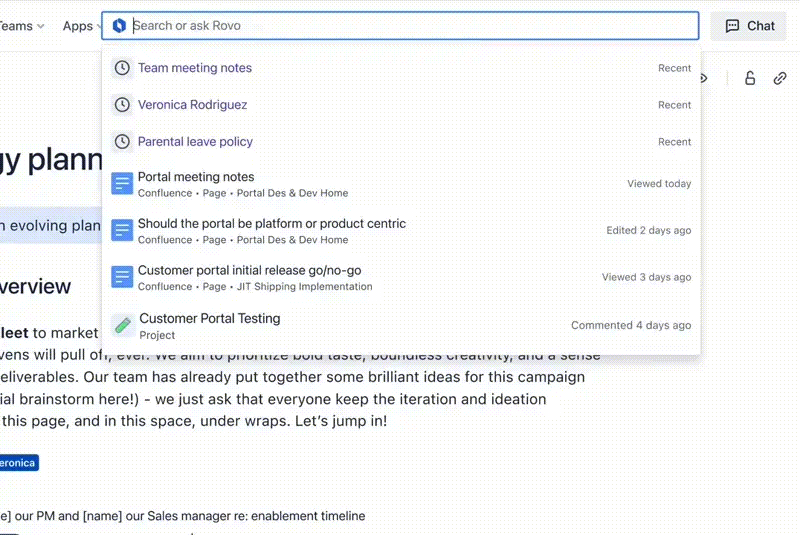During its Team ’24 conference in Las Vegas, Atlassian today launched Rovo, its new AI assistant. Rovo can take data from first- and third-party tools and make it easily accessible through a new AI-powered search tool and other integrations into Atlassian’s products. The most interesting part, though, may be the new Rovo Agents, which can be used to automate workflows in tools like Jira and Confluence. One nifty aspect of these agents: anyone can build them using a natural language interface. No programming required.
“We like to think of Rovo as a large knowledge model for organizations. It’s a knowledge discovery product for every knowledge worker,” Sherif Mansour, Atlassian’s head of product for Atlassian Intelligence, told TechCrunch. “When you look at what a knowledge worker has to do, they sort of go through this process of: I need to find a piece of work. I need to learn and understand it. And then I take an action. Most people that have some sort of desk job go through that loop. I think what’s exciting about Rovo is that we’re finally at the genesis of generative AI landing that that helps accelerate what we can do in that area for teams.”
The basis for Rovo is Atlassian’s ‘cloud teamwork graph,’ the same graph that also forms the foundation of Atlassian Intelligence, the company’s year-old effort of bringing an AI teammate to its products. That graph brings together data from Atlassian’s own products and a number of third-party SaaS tools. And in a way, it’s the proliferation of SaaS tools that necessitates applications like Rovo, because every tool tends to have its own data silo, making it harder for employees to find the information they need.
Rovo, Mansour said, revolves around three pillars of teamwork: helping teams find and connect with their work, helping those teams learn, and then helping them take action.
In a way, enterprise search is the low-hanging fruit here, since Atlassian is already aggregating all of this data. But it’s also a tool that should prove immediately useful for its users and keep them from having to constantly switch contexts to find information. Some of the third-party tools that are supported out of the box include Google Drive, Microsoft SharePoint, Microsoft Teams, GitHub, Slack, and Figma.
Enterprises, which often have lots of custom tools, can also build their own connectors. Atlassian itself, for example, built a connector that brings in its internal developer documentation. Simply making that documentation available in Rovo, Mansour said, saved developers an hour or two every week — a higher time savings than what those same developers report from using an AI code generation tool.
As Mansour stressed, the biggest technical challenge — aside from building the AI infrastructure to power Rovo — is building all of these connectors and ensuring that they respect the access permission set by a company’s IT and security teams. “When you search, you get a different set of results to my search. We make sure that it’s tailored to you and respects your permissions — and only [shows] what you have access to.”
It wouldn’t be 2024 if Rovo didn’t also come as a chat service. Since it also has access to all of this data, it’s a relatively easy task to use retrieval-augmented generation (RAG) to feed a large language model with it and have the model provide customized answers.
Even when using RAG, large language models are still susceptible to hallucinations (though RAG greatly reduces the chances of the model going off script). To ensure that users can trust the results, Rovo always cites its sources, and most of the time (with slideshows and Figma designs, for example), there is even an interactive preview.
One interesting feature Atlassian also built into Rovo is its ability to detect and explain company jargon. There is even a Chrome extension for this that will automatically underline and explain a certain company-specific term as you read a Google Doc, for example. This feature is powered by Rovo’s semantic search engine.
Virtual Teammates
It’s one thing to find information. It’s another to take action on it. That’s where Rovo Agents comes in. In a way, this is an extension of what the company did with Atlassian Intelligence. Indeed, the company describes Rovo Agents as “virtual teammates,” too.
“Rovo Agents will transform teamwork with their ability to synthesize large volumes of enterprise data, break down complex tasks, learn as they take action, and partner with their human teammates to make critical and complex decisions,” Mansour writes in today’s announcement. “Agents aren’t just some souped-up version of chatbots. They bring specialized knowledge and skills to a wide variety of workflows and processes.”
That means they can generate, review and edit content for for marketing use, product specs or Jira issues. Users can also build agents that answer specific questions or recommend best practices. But more importantly, they can automate tasks based on when a Jira issue progresses, for example, or help users clean up their Jira backlogs or organize Confluence pages — all with humans in the loop.
“We have a strong belief that the future of teamwork is teammates working alongside virtual teammates — agents,” Mansour said. “There’ll be many of them and you’ll be interacting with them in your day-to-day workflows.”







